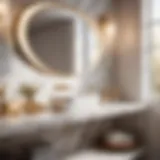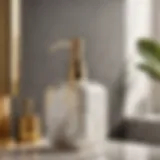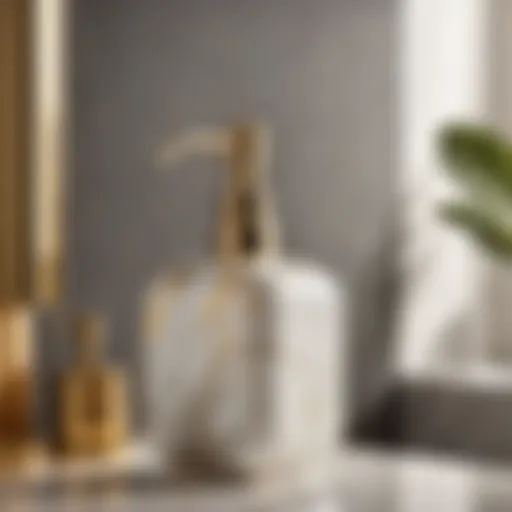Top Indoor Plants Perfect for Indirect Light
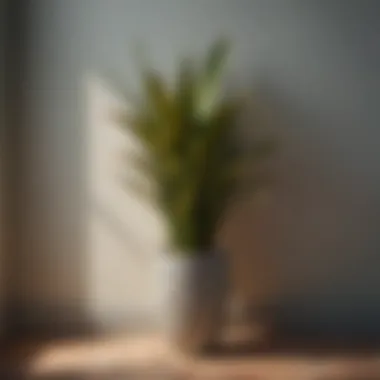

Intro
In the hustle and bustle of daily life, transforming your living space into a serene haven can be a true breath of fresh air. Especially for those busy individuals, incorporating indoor plants can be a game changer. However, not everyone has the luxury of direct sunlight pouring through their windows all day long. Fortunately, many plants flourish in environments with indirect light. This article will help you navigate the lush world of greenery that can beautify your home, even when the sun isn’t shining directly.
Whether you're a novice or have had a green thumb for ages, this comprehensive guide sheds light on various species that thrive in indirect light. From understanding their care requirements to choosing the right spots for optimal growth, you’ll learn how to create a harmonious indoor environment. First, let’s gather everything we need to get started on this green journey.
Materials:
Before diving into the world of indoor plants, it’s essential to have a well-thought-out list of materials. Here’s what you’ll need:
- Indoor plants suitable for indirect light:
- Planters:
- Potting Mix:
- Watering Can:
- Trowel or Soil Scoop:
- Fertilizer:
- Plant Labels (optional):
- Spray Bottle:
- Snake Plant (Sansevieria) – 1 or more pots
- Pothos (Epipremnum aureum) – 1 pot
- ZZ Plant (Zamioculcas zamiifolia) – 1 pot
- Peace Lily (Spathiphyllum) – 1 pot
- Spider Plant (Chlorophytum comosum) – 1 pot
- Terracotta or ceramic pots that allow proper drainage, 6-10 inches in diameter
- High-quality potting mix, about 2-3 bags (1.5 cubic feet each)
- 1-liter capacity for easy handling
- 1 standard-sized scoop for efficient planting
- Balanced liquid fertilizer, 1 bottle (preferably organic)
- For tagging your plants, a pack of 10
- To maintain humidity, 500 ml
DIY Steps:
Creating a serene indoor space with plants can be both a rewarding and enjoyable endeavor. Let’s break down the steps to ensure you do it right:
- Plan Your Layout:
Choose areas in your home that receive indirect sunlight. Corners, near windows that do not face the sun directly, or rooms with filtered light are ideal. - Select Your Plants:
Choose from the list of indoor plants that thrive in the indirect light. Each has its unique characteristics that contribute to your space’s aesthetic. - Prepare the Planters:
Ensure your pots have drainage holes. Fill them about one-third full with potting mix. - Pot the Plants:
Gently remove each plant from its nursery pot, loosening the roots if they are tightly packed. Position it in the center of your planter and fill around with soil, firming it in place. - Water Thoroughly:
After potting, water each plant until it drains from the bottom. Be sure not to overwater. - Label Your Plants:
If using labels, tag them with their names. This can help you remember their specific care requirements. - Position Your Plants:
Place them in the predetermined locations. Ensure they are not crowded to allow for growth. - Monitor and Maintain:
Water according to each plant’s needs and use fertilizer as per the instructions on the bottle, typically every few weeks during the growing season.
Technical Aspects:
To ensure your indoor plants thrive, consider these key technical aspects:
- Tools:
- Timing Specifics:
- Critical Techniques:
- Trowel or Soil Scoop, Watering Can, Spray Bottle for humidity
- Water your plants every week, monitoring moisture levels in the soil. Adjust as necessary based on seasonal changes.
- Always water deeply and let the water drain completely. This encourages root growth and keeps the plants healthy.
DIY project Process:
Seeing your plants flourish is the ultimate reward. Follow these sequential steps for successful installation and bonding with your greenery:
- Initial Placement:
After positioning your plants, observe how they adapt to their new spots. Move them around if they appear to be straining towards light sources. - Regular Checks:
Keep an eye on the leaves. If they start to yellow or brown, consider adjusting your watering routine or location. - Pruning:
Occasionally remove any dead or yellowing leaves to keep your plants looking their best.
Troubleshooting Tips:
Even seasoned plant owners run into challenges. Here are some common mistakes and their solutions:
- Problem: Leaves yellowing.
- Problem: Stunted growth.
- Solution: This could be a sign of overwatering. Ensure the pot drains well and reduce watering.
- Solution: Make sure the plant isn’t receiving too much or too little light. Adjust its position if necessary.
"Gardening is the purest of human pleasures."
– Francis Bacon
By carefully selecting plants that flourish in indirect light and addressing their needs, you can create a vibrant indoor garden that’s both visually appealing and nurturing. The combination of greenery not only enhances your living spaces but also contributes to your overall well-being.
Understanding Indirect Light
Grasping the concept of indirect light is crucial for anyone looking to cultivate indoor plants successfully. Light serves as the primary energy source for plants, and understanding how it interacts within your indoor space will determine the health of your green companions. Some may think that having a sunny window is the key to nurturing beautiful plants, but there's more nuance to it. This section will cover the significance of indirect light for indoor plants, clarifying what it is and how you can measure it effectively.
Defining Indirect Light
When we talk about indirect light, we refer to that soft, diffused light that doesn't come directly from the sun's rays. Instead, it often bounces off walls or reflects from surfaces. This type of light creates an environment that's gentle on plant foliage while providing enough energy for growth. For instance, if you stand in front of a window but the sunlight doesn’t hit you directly, you’re experiencing indirect light. So, it’s safe to say that indirectly lit areas are less harsh, which can be beneficial for certain plant species that might struggle under the intensity of direct sunlight.
Differences Between Direct and Indirect Light
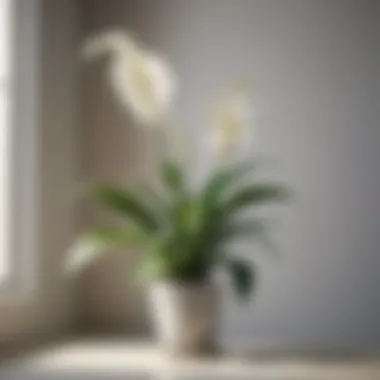

Understanding the distinction between direct and indirect light can help avoid overexposure or underexposure of your plants:
- Direct Light: This is when sunlight shines straight onto the plant, often characterized by strong brightness and warmth. Plants that thrive in direct light typically include succulents or cacti.
- Indirect Light: On the flip side, this is the light that has been diffused or filtered. Not all plants take well to direct exposure, and instead, they flourish where light is less intense. Examples include the popular pothos and snake plants.
An important point to note is that indirect light can vary in intensity depending on factors such as location, time of day, and even the season. This variability makes it essential to keenly observe conditions in your home.
Measuring Light Levels Indoors
To ensure you give plants the best chance of thriving, you might want to measure light levels indoors. There are simple methods to do this, including the use of a light meter or relying on a subjective method:
- Light Meter: You can buy a basic light meter which allows for precise readings. It will measure the amount of light in foot-candles or lux.
- Subjective Method: Stand in the area where you plan to place your plant. If you can read comfortably without a lamp, you're likely in a well-lit indirect light area. Conversely, struggling to read might suggest lower light levels.
- Observe Plant Response: Placing a plant in your chosen area for a few days can also give insight. If the leaves start yellowing or dropping off, it may be a sign of inappropriate lighting conditions.
By understanding and properly assessing indirect light, you can create an environment that fosters growth and vitality for your indoor plants. If you get this part right, you'll be well on your way to a thriving indoor garden that not only beautifies your space but also contributes positively to your overall well-being.
"Understanding the nuances of light can transform a struggling plant into a flourishing centerpiece in your home."
Factors to Consider for Indoor Plant Selection
Selecting the right indoor plants for your home or office isn’t merely about aesthetics; it’s about creating an environment where these plants can thrive. When considering factors for indoor plant selection, you’re not just choosing which foliage looks good on Instagram. Instead, it’s crucial to analyze multiple elements that can impact a plant's health and longevity. To sum it up, understanding these factors helps in fostering a harmonious indoor ecosystem that promotes both beauty and well-being.
Plant Size and Space Constraints
When it comes to picking plants, size matters—quite literally. Before you hit the garden center, take a long, hard look at the space you have to work with. A towering snake plant can be a showstopper in a spacious living room but may feel cramped in a tiny apartment. Measure your area to ensure you have enough room for plants to grow, not just to squeeze them in.
- Small Spaces: If you're tight on space, consider compact options like succulents or smaller varieties of Pothos. They don’t need much room but still pack a punch in aesthetic value.
- Larger Areas: For those with grander spaces, think about bigger plants. A Fiddle Leaf Fig could steal the show and add a nice vertical feel to your room.
In addition to height, consider how plants will fill space. Grouping smaller plants together can create a lively arrangement while keeping larger specimens showcased individually.
Humidity and Temperature Preferences
Every plant has its own personality. Some revel in humidity, while others prefer it dry as a bone. Knowing the humidity levels and temperature ranges suitable for your chosen plants is one of the fundamental aspects in plant selection.
- Humidity Lovers: Tropical plants, such as the Peace Lily or Chinese Evergreen, thrive in humid conditions. If your indoor environment resembles a desert (dry air), you may need to either invest in humidity trays or keep a spray bottle handy.
- Temperature Tolerance: Make sure to check whether your new plant can tolerate your indoor temperature. Most indoor plants are fine with 65-75°F, but some, like Dracaena, may struggle in extreme heat or the cold drafts.
"It’s not just about choosing the right plant; it’s about providing the right home for them."
Maintenance Requirements
Let's be honest: not everyone has the green thumb required for high-maintenance plants. Some folks juggle busy lives, so the last thing needed is a plant screaming for attention. Assessing maintenance requirements is vital, as it should match your lifestyle.
- Low Maintenance: If you’re looking for easy-going plants, consider the ZZ Plant or Snake Plant. They can withstand neglect and only require occasional watering.
- Medium to High Maintenance: On the flip side, those who can dedicate time might enjoy the complexities of Philodendrons or Spider Plants, which demand more regular care—think consistent watering and occasional pruning.
In summary, carefully analyzing these factors—size, environmental preferences, and maintenance levels—can drastically improve your chances of success with indoor plants. By putting thought into these considerations, you’ll not just beautify your space but create an enriching environment for both you and your green companions.
Ideal Indoor Plants for Indirect Light
Choosing the right indoor plants can transform a dull space into a vibrant one. Plants grown in indirect light can thrive in areas that might not receive direct sunlight, making them ideal for those spots in your home where sunbeams rarely reach. When selecting plants for these conditions, one needs to consider not only the aesthetic appeal but also the specific care needs of each species. Having a greenscape that benefits from indirect sunlight not only brightens the room but can enhance the overall well-being of the home’s occupants. It’s the connection between the environment and the plants that helps create a harmonious living space.
Snake Plant
Characteristics and Growth Habit
The Snake Plant, or Sansevieria, is known for its robust and sculptural leaves. They grow upwards in a spear-like fashion, creating an architectural vibe that attracts attention. One of their key characteristics is that they tolerate neglect. This makes them a popular choice for those who may not have a green thumb. A unique aspect of their growth habit is that they can thrive in almost any indoor environment, even under low light conditions. While they are versatile, it’s essential to note that their susceptibility to overwatering can be a downside.
Care Guidelines
Caring for Snake Plants is quite straightforward, making them a beneficial choice for busy individuals. They prefer to dry out between waterings due to their native arid habitat. The guidance here is clear: water sparingly, especially in winter months when growth slows down. The unique feature of these plants is they’re also known for their air-purifying qualities. They help filter toxins from the air, contributing to healthier indoor spaces.
Common Issues
Common issues faced with Snake Plants include root rot, mainly from overwatering. Another concern is their leaf tips turning brown, which could indicate a need for more humidity. Recognizing these signs early can help you maintain a healthy plant without losing its striking presence in your home.
ZZ Plant
Characteristics and Growth Habit
The ZZ Plant, known scientifically as Zamioculcas zamiifolia, boasts glossy leaves that add shine to any area. Its growth habit is unique in that it can survive in very low light, making it a solid option for darker rooms. This plant’s resilience is a key characteristic, allowing it to flourish with little effort. A distinct advantage here is that ZZ Plants can grow in a variety of conditions—an attractive proposition for many households.
Care Guidelines
When it comes to care, ZZ Plants are low maintenance. They thrive best when kept in dry soil, reflecting their origin in drought-prone environments. A key point in their care is ensuring they’re not overwatered, as this can lead to problems. The benefit of minimal care requirements adds to their appeal, especially for busy homeowners.
Common Issues
Among common issues, overwatering is the most prevalent, leading to root rot. Yellowing leaves can signal this problem, making it crucial for caretakers to monitor their watering habits. Additionally, watch for leggy growth due to insufficient light. These common pitfalls can be managed with awareness and attentiveness.
Pothos
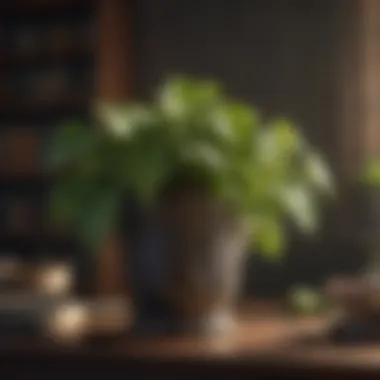

Characteristics and Growth Habit
Pothos, or Epipremnum aureum, is often dubbed the “devil’s ivy,” due to its vigorous growth. With trailing vines and heart-shaped leaves, it brings a lively touch to any room. Its versatility in growth allows it to adapt from being a tabletop plant to a hanging beauty. This adaptability is a significant feature, allowing for numerous creative placements around the home.
Care Guidelines
Pothos plants prefer to dry out between waterings and enjoy a moderate level of humidity. Regular pruning encourages fuller growth, a practice that also enhances its aesthetic appeal. Their low maintenance and rapid growth rate make them a favorite amongst novice plant lovers. However, too much direct sunlight can scorch their leaves, which should be avoided to keep them looking their best.
Common Issues
Common issues with Pothos include pests like mealybugs and spider mites, which can hinder their love for indirect light. Signs of distress can manifest as yellowing or wilting leaves. Keeping a close eye on plant condition will help mitigate these problems and maintain the beauty of the foliage.
Spider Plant
Characteristics and Growth Habit
A Spider Plant, scientifically named Chlorophytum comosum, exhibits arching green-and-white striped leaves. Its potent ability to purify air is a notable characteristic. Spider plants propagate easily, often producing what looks like baby plants or 'pups' at the end of long stems. This aspect of their growth habit is both charming and practical for those wanting to expand their indoor greenery without extra cost.
Care Guidelines
These plants thrive in bright, indirect sunlight but can tolerate low light. Regular watering is required, but letting the soil dry out between waterings is critical for optimal growth. They can benefit from occasional feeding to promote lush foliage. The ability to overcome a wide range of care conditions is what makes them ideal for many households.
Common Issues
Common issues can include browning leaf tips, often a response to inconsistent watering or low humidity. Root rot is another concern, usually linked to overly wet soil. Being attuned to their needs will ensure a healthy, thriving Spider Plant in your home.
Peace Lily
Characteristics and Growth Habit
The Peace Lily, known scientifically as Spathiphyllum, is famed for its glossy leaves and distinctive white blooms. This plant offers not just beauty; it’s an effective air purifier. Its ability to thrive in lower light conditions while still delivering flowering capabilities makes it an enticing choice for indoor setups. The unique blooms provide a touch of elegance, often drawing admiration from guests.
Care Guidelines
Peace Lilies prefer moist soil but should not be waterlogged. Regular misting can help keep the plant humid and thriving. When caring for a Peace Lily, understanding its water needs is essential, making it a rewarding choice when tended properly. The gracefulness of its blooms adds a touch of elegance to spaces without requiring excessive effort.
Common Issues
Common issues include drooping leaves, which often indicate the plant needs water. Additionally, yellowing leaves may signal too much sunlight or improper watering habits. Being proactive in addressing these symptoms can keep this stunning plant flourishing.
Chinese Evergreen
Characteristics and Growth Habit
The Chinese Evergreen, or Aglaonema, is prized for its striking foliage. Available in various colors, its resilient nature and ability to adapt to various light conditions make it appealing. A critical characteristic is its capacity to withstand low light, which attracts many who seek greenery in dim areas of their home.
Care Guidelines
These plants prefer filtered light but can survive well in low light. They thrive best when watered moderately, ensuring the soil drains well. A unique feature of the Chinese Evergreen is its ability to thrive in less-than-ideal conditions, attracting those who appreciate manageable houseplants.
Common Issues
Common issues include browning leaf tips and poor growth, often stemming from improper watering or light exposure. Prompt attention to these conditions will help maintain the plant's vibrant health and appearance.
Dracaena
Characteristics and Growth Habit
Dracaena species are known for their varied growth habits, which include tall, striking forms. They can add a beautiful touch to various indoor spaces. A distinctive feature is their resilience to low-light conditions, setting them apart as a wonderful choice.
Care Guidelines
Caring for Dracaena typically involves ensuring moderate sunlight along with regular watering, allowing the topsoil to dry out between sessions. Their ability to tolerate occasional neglect adds to their charm, establishing them as a go-to option for busy individuals.
Common Issues
Common issues here include leaf drop and discoloration, mainly linked to overwatering or low light conditions. Being attentive to these signs is vital for keeping your Dracaena healthy and visually appealing.
Philodendron
Characteristics and Growth Habit
Philodendrons are loved for their heart-shaped leaves and climbing nature. They are also known for their adaptability to various light environments. This adaptability allows for creative placements around the home, catering to those who may want different elevations and styles in plant displaying.
Care Guidelines
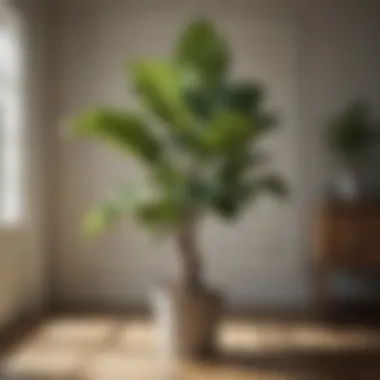

They prefer moist, well-draining soil and humidity. Typically, they like to dry out slightly between waterings, responding well to a little extra humidity from occasional misting. The unique feature is their versatility in care practices, accommodating both novice and experienced plant caregivers.
Common Issues
Common issues include yellowing leaves that may indicate overwatering or poor light exposure. Being vigilant with care can mitigate these problems, ensuring your Philodendron maintains its lush appearance.
Placement Strategies for Optimizing Growth
Optimizing the placement of indoor plants is crucial for their overall health and vitality. This section discusses various strategies to effectively position plants in a way that enhances growth while ensuring they thrive in indirect light. By understanding the unique requirements of different plants and how to work with your indoor environment, you can foster lush greenery in any space.
Identifying the Best Locations Indoors
Finding the right spots for your plants can be a game changer. Not all corners of your home or office are suitable for plant growth. When assessing potential locations, consider the amount of natural light that filters through the windows at different times of the day. Ideally, you want to find areas where light is both sufficient and gentle, minimising harsh rays that can scorch delicate leaves.
- North-facing windows: Generally, they provide consistent but low light. Great for shade-loving plants like pothos or peace lilies.
- East-facing windows: Benefit herbs and other plants needing moderate light in the morning. The sun won’t be too intense, making this spot a fantastic choice for a variety of species.
- West-facing windows: It’s usually bright in the afternoon, so try to position light-hungry plants like dracaena here, but keep in mind to monitor them for any signs of stress on particularly hot days.
- Avoid dark corners: They may not sustain vigorous growth. Instead, consider using artificial lights if necessary to supplement light in these underexposed areas.
Utilizing Reflective Surfaces
Harnessing reflective surfaces can be an underappreciated aspect of indoor gardening. Mirrors, glass tables, and even light-colored walls can bounce light around the room, increasing the amount of indirect light available to your plants. Properly placed, these reflective surfaces can amplify your existing light conditions and create a bright atmosphere for your indoor garden.
For example:
- Mirrors: Position a mirror nearby a plant to double the light efficiency without exposing it directly to harsh rays. Some clever positioning can really do wonders.
- Light-colored walls: These can reflect sunlight into darker areas of the room. A well-lit space with walls painted in light colors or with reflective wallpaper can create a more inviting environment for your green friends.
Adjusting to Seasonal Changes
Indoor plant care requires attention to seasonal variations in light conditions. Over the course of the year, the angle and intensity of sunlight will change. This fluctuation might mean that your plants are getting more or less light than they need.
- Winter: Days are shorter, and light intensity drops. You might need to shift your plants closer to windows or add supplemental lighting to ensure they receive adequate light.
- Summer: Plants that thrived in winter’s indirect light might find themselves overwhelmed when days grow long. Being proactive in monitoring their conditions and relocating them as needed is important.
- Use seasonal checklists: These can help remind you when to rotate or relocate plants as light conditions shift. This doesn’t just help prevent potential sunburns but also keeps your indoor garden healthier.
Remember: Small changes in plant positioning can lead to significantly improved health and vitality.
With thoughtful strategies in place, your indoor plants can flourish, providing beauty and well-being to your home with even the gentlest touch of light. Always balance the specific needs of your plants with the unique characteristics of your living space. Smart placement is the secret sauce to thriving indoor greenery.
Maintaining Healthy Indoor Plants
Ensuring that your indoor plants remain vibrant and healthy is a key aspect of creating a flourishing indoor environment. Healthy plants not only enhance the aesthetic appeal of your home but also contribute to your overall well-being. Proper maintenance plays a significant role in promoting better air quality and creating a tranquil atmosphere. Neglecting plant care can lead to issues like root rot, pest infestations, or stunted growth. Thus, whether you are a seasoned plant parent or just venturing into the world of indoor greenery, focusing on the following elements will secure a lush and joyful indoor garden.
Watering Practices
Watering is often the most crucial, yet frequently misunderstood, aspect of indoor plant care. Every plant has its own specific water needs depending on species, size, and environmental conditions.
- Frequency matters: Rather than adhering to a strict schedule, observe the soil's moisture level. A plant may require more water in the hotter months than during winter when growth slows.
- Signs of thirst: Check the leaves and stems for drooping or yellowing; these could signal that your plant is in dire need of a drink.
- Technique: It helps to water deeply but infrequently. Allow excess water to drain away to prevent waterlogging.
Remember, overwatering is usually more harmful than under-watering.
Fertilization Techniques
While water is essential, it isn't enough to keep your plants growing strong. Fertilization occasionally gives your plants the boost they need to thrive.
- Choosing the right fertilizer: Organic options, like worm castings or compost tea, can enrich your plants without the harsh chemicals.
- Frequency: During the growing season, typically spring and summer, a light feeding every four to six weeks is beneficial. In fall and winter, most indoor plants go dormant, requiring little to no fertilizer.
- Avoiding burn-out: Diluting fertilizer to half-strength when you apply it can reduce the chance of root burn, which can negatively affect the plant's health.
Pruning and Re-potting
Pruning not only shapes your plants but is key to their overall health. Removing dead or yellowing leaves allows for better air circulation and directs nutrients to the healthier parts of the plant.
- When to prune: This should be ideally done in early spring when the plant begins to grow again.
- Re-potting: Don’t forget about repotting! If you notice roots sticking out of drainage holes or the plant isn’t growing well, it’s time to move it to a larger pot.
Pest and Disease Management
Even the most meticulous plant care routines may encounter challenges in the form of pests or diseases. Regular monitoring is essential for catching issues early.
- Identify common pests: Familiarize yourself with common nuisances like spider mites, aphids, or mealybugs. These often hide in the leaf axils or on the underside of leaves.
- Natural predators: Consider introducing beneficial insects like ladybugs or using neem oil to help control pest populations without chemical treatments.
- Signs of disease: Look out for wilting, discoloration, or stunted growth. Polish up on disease awareness, as early detection can save a suffering plant.
Maintaining your indoor plants is not just about the mechanical tasks, but also about tuning into their needs. By providing consistent care, observation, and attention, you can cultivate an indoor oasis that thrives and contributes positively to your living space.
Closure
The concluding section of this article serves as the final chord in the symphony of understanding indoor plants that thrive in indirect light. Here, we gather insights that have been woven throughout the previous sections, solidifying the key aspects of plant selection, placement, and care. Understanding these factors isn't just beneficial; it’s fundamental for anyone aiming to integrate greenery into their living spaces. Each plant we've discussed—be it the robust Snake Plant or the elegant Peace Lily—has its own unique charm and care needs, which can truly transform the ambiance of a home or workplace when paired with appropriate lighting conditions.
Summarizing Key Takeaways
- Understanding Indirect Light: Knowing how to define indirect light and its differences from direct light helps in making informed choices. Most plants discussed flourish when placed a few feet away from windows, allowing them to gather needed brightness without being scorched.
- Key Plant Choices: The selection of indoor plants such as the ZZ Plant, Pothos, and Chinese Evergreen not only caters to aesthetic desires but also to varying lifestyles—whether you’re a diligent caretaker or a busy professional with little time.
- Placement and Maintenance Strategies: Proper placement is vital. Utilizing reflective surfaces or adjusting placements with changing seasons ensures that the plants receive adequate light while adding to the decorative element of the indoor landscape.
- Ongoing Care: Regular watering, fertilization, and knowing when to prune are crucial for maintaining the health of these plants. Most thrive in neglect, yet even low-maintenance plants require attention periodically to flourish.
By keeping these key elements in mind, readers can cultivate their indoor gardens effectively, ensuring that every leaf and bloom contributes not just to the decor but to the overall well-being of their spaces.
Encouraging Exploration of Indoor Greenery
To instill greenery in your home isn’t merely to add decoration; it’s a journey into nurturing life. With so many options suited for indirect light, the possibilities are abundant. Take time to explore different species, as each brings its own personality and beauty. Consider visiting a local plant nursery or engaging with online forums like Reddit’s r/plants or specific Facebook groups dedicated to houseplants. Engaging with fellow plant enthusiasts can provide fresh perspectives and tips.
Furthermore, fostering an environment of growth extends beyond just the plants. It's about creating spaces that resonate with nature, enhancing air quality, and promoting a calming atmosphere. Studies show that incorporating plants can significantly lower stress levels and improve mood over time.
So, don’t hesitate—choose a few plants that speak to you, and start discovering the joys of indoor gardening. Let the greenery evolve along with your space, creating a sanctuary of tranquility and beauty.
